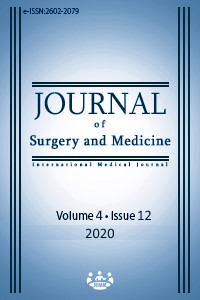An evaluation of functional outcome in elderly patients with proximal humeral fractures treated conservatively
Keywords:
Proximal humerus fractures, Conservative Treatment, Elderly PatientsAbstract
Aim: The relationship between radiological data and the clinical outcomes in elderly patients with incomplete proximal humeral fractures treated conservatively is limited and controversial in the literature. We aimed to report the short-to-mid-term results of the radiological data and functional outcome in these patients. Methods: A total of 114 patients over 65 years of age, diagnosed with unilateral isolated incomplete proximal displaced humerus fractures, and treated conservatively, were recruited in the study. Demographic characteristics, radiological data and clinical scores of all patients were recorded. Fractures were classified according to the Neer classification. Functional evaluation of patients was performed via Quick-Disabilities of Arm, Shoulder, and Hand (Quick-DASH) and Visual Analog Scale (VAS). Results: Mean VAS and Quick-DASH scores of the patients were 3.6 (1.4) and 34.5(13.7), respectively, both of which changed significantly as the number of the parts of fracture increased (P=0.02 and P=0.04, respectively). The VAS and the Quick-DASH scores were significantly higher in females (P=0.02 and P=0.03, respectively), similar among the smokers (P=0.58 and P=0.41, respectively), and significantly higher in diabetic and osteoporotic patients (P<0.001 and P=0.39, respectively). Conclusion: Functional outcomes after conservative follow-up in patients over 65 years of age with incomplete proximal humerus fractures are good in most patients. Therefore, conservative treatment can be an option regardless of the fracture type in elderly patients with incomplete proximal humeral fractures.
Downloads
References
Fink HA, Ensrud KE, Nelson DB, Kerani R, Schreiner PJ, Zhao Y, et al. Disability after clinical fracture in postmenopausal women with low bone density: the fracture intervention trial (FIT). Osteoporos Int. 2003;14(1):69-76.
Palvanen M, Kannus P, Niemi S, Parkkari J. Update in the epidemiology of proximal humeral fractures. Clin Orthop. (1976-2007) 2006;442:87-92.
Bell J-E, Leung BC, Spratt KF, Koval KJ, Weinstein JD, Goodman DC, et al. Trends and variation in incidence, surgical treatment, and repeat surgery of proximal humeral fractures in the elderly. J Bone Joint Surg Am. 2011;93(2):121.
Murray I, Amin A, White T, Robinson C. Proximal humeral fractures: current concepts in classification, treatment and outcomes. J Bone Joint Surg Br. 2011;93(1):1-11.
Vrancken PM-JT, Kastelein GW, Breslau PJ. Proximal humerus fractures a prospective study of the functional outcome after conservative treatment. Eur J Trauma. 2001;27(3):133-6.
Court-Brown C, Cattermole H, McQueen M. Impacted valgus fractures (B1. 1) of the proximal humerus: the results of non-operative treatment. J Bone Joint Surg Br. 2002;84(4):504-8.
Smith AM, Mardones RM, Sperling JW, Cofield RH. Early complications of operatively treated proximal humeral fractures. J Shoulder Elbow Surg. 2007;16(1):14-24.
Hanson B, Neidenbach P, de Boer P, Stengel D. Functional outcomes after nonoperative management of fractures of the proximal humerus. J Shoulder Elbow Surg. 2009;18(4):612-21.
Court-Brown C, McQueen M. The impacted varus (A2. 2) proximal humeral fracture Prediction of outcome and results of nonoperative treatment in 99 patients. Acta Orthop Scand. 2004;75(6):736-40.
Zyto K. Non-operative treatment of comminuted fractures of the proximal humerus in elderly patients. Injury 1998;29(5):349-52.
Charles S Neer I. Displaced proximal humeral fractures: Part II. Treatment of three-part and four-part displacement. JBJS. 1970;52(6):1090-103.
Kennedy CA, Beaton DE, Smith P, Van Eerd D, Tang K, Inrig T, et al. Measurement properties of the QuickDASH (disabilities of the arm, shoulder and hand) outcome measure and cross-cultural adaptations of the QuickDASH: a systematic review. Qual Life Res. 2013;22(9):2509-47.
Angst F, Schwyzer HK, Aeschlimann A, Simmen BR, Goldhahn J. Measures of adult shoulder function: Disabilities of the Arm, Shoulder, and Hand Questionnaire (DASH) and its short version (QuickDASH), Shoulder Pain and Disability Index (SPADI), American Shoulder and Elbow Surgeons (ASES) Society standardized shoulder assessment form, Constant (Murley) Score (CS), .... Arthritis Care Res. (Hoboken) 2011;63(S11):S174-S88.
Aun C, Lam Y, Collett B. Evaluation of the use of visual analogue scale in Chinese patients. Pain. 1986;25(2):215-21.
Court-Brown C, Garg A, McQueen M. The translated two-part fracture of the proximal humerus: epidemiology and outcome in the older patient. J Bone Joint Surg Br. 2001;83(6):799-804.
Vallier HA. Treatment of proximal humerus fractures. J Orthop Trauma. 2007;21(7):469-76.
Rasmussen S, Hvass I, Dalsgaard J, Christensen B, Holstad E. Displaced proximal humeral fractures: results of conservative treatment. Injury. 1992;23(1):41-3.
van den Broek CM, van den Besselaar M, Coenen JM, Vegt PA. Displaced proximal humeral fractures: intramedullary nailing versus conservative treatment. Arch Orthop Trauma Surg. 2007;127(6):459-63.
Fjalestad T, Strømsøe K, Blücher J, Tennøe B. Fractures in the proximal humerus: functional outcome and evaluation of 70 patients treated in hospital. Arch Orthop Trauma Surg. 2005;125(5):310-6.
Stableforth P. Four-part fractures of the neck of the humerus. J Bone Joint Surg Br. volume 1984;66(1):104-8.
Yüksel HY, Yimaz S, Aksahin E, Çelebi L, Muratli HH, Biçimoglu A. The results of nonoperative treatment for three-and four-part fractures of the proximal humerus in low-demand patients. J Orthop Trauma. 2011;25(10):588-95.
Schai P, Imhoff A, Preiss S. Comminuted humeral head fractures: a multicenter analysis. J Shoulder Elbow Surg. 1995;4(5):319-30.
Zyto K, Ahrengart L, Sperber A, Törnkvist H. Treatment of displaced proximal humeral fractures in elderly patients. J Bone Joint Surg Br. 1997;79(3):412-7.
Goldman RT, Koval KJ, Cuomo F, Gallagher MA, Zuckerman JD. Functional outcome after humeral head replacement for acute three-and four-part proximal humeral fractures. J Shoulder Elbow Surg. 1995;4(2):81-6.
Kontakis G, Koutras C, Tosounidis T, Giannoudis P. Early management of proximal humeral fractures with hemiarthroplasty: a systematic review. J Bone Joint Surg Br. 2008;90(11):1407-13.
Rees J, Hicks J, Ribbans W. Assessment and management of three-and four-part proximal humeral fractures. Clin Orthop Relat Res. (1976-2007) 1998;353:18-29.
Downloads
- 624 678
Published
Issue
Section
How to Cite
License
Copyright (c) 2020 Emre Çalışal
This work is licensed under a Creative Commons Attribution-NonCommercial-NoDerivatives 4.0 International License.
















